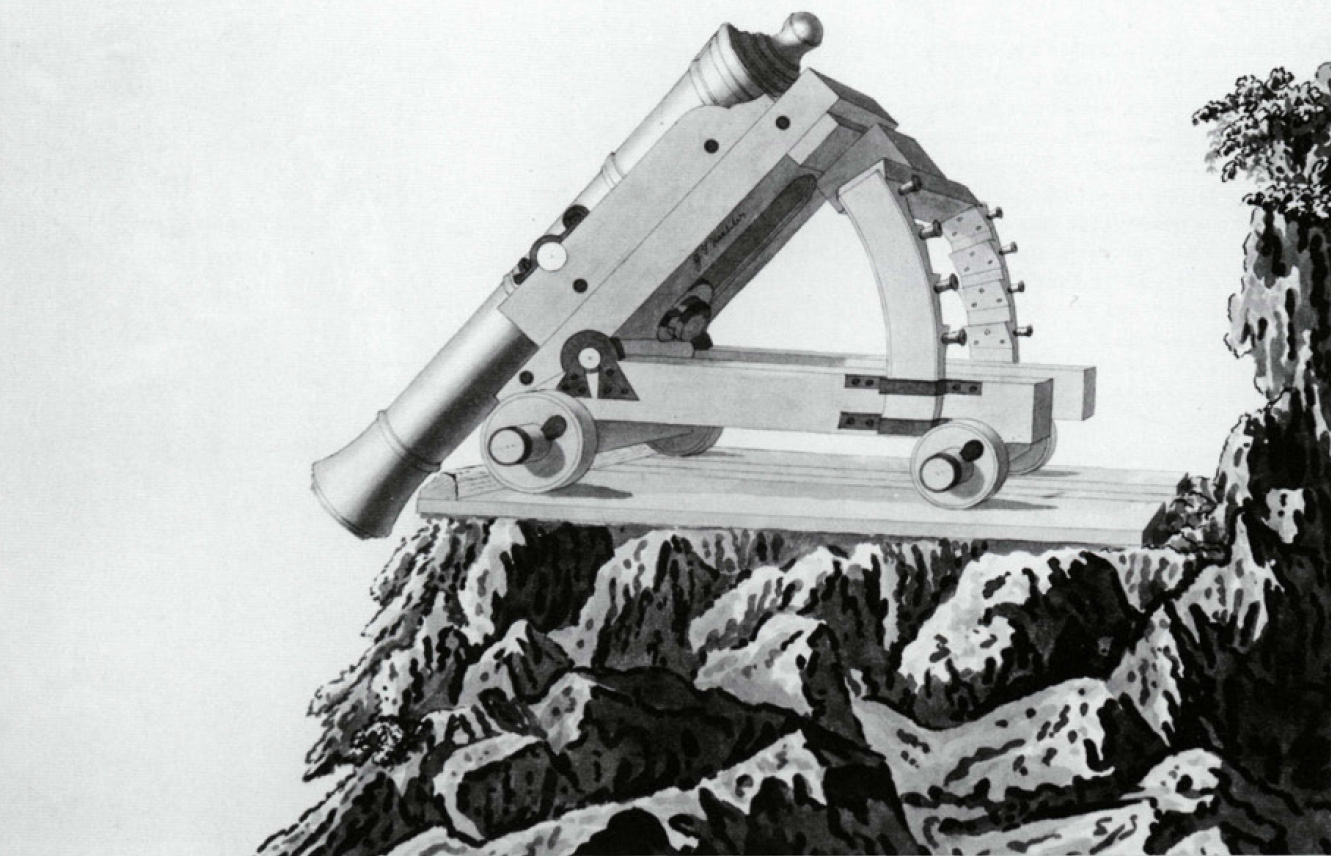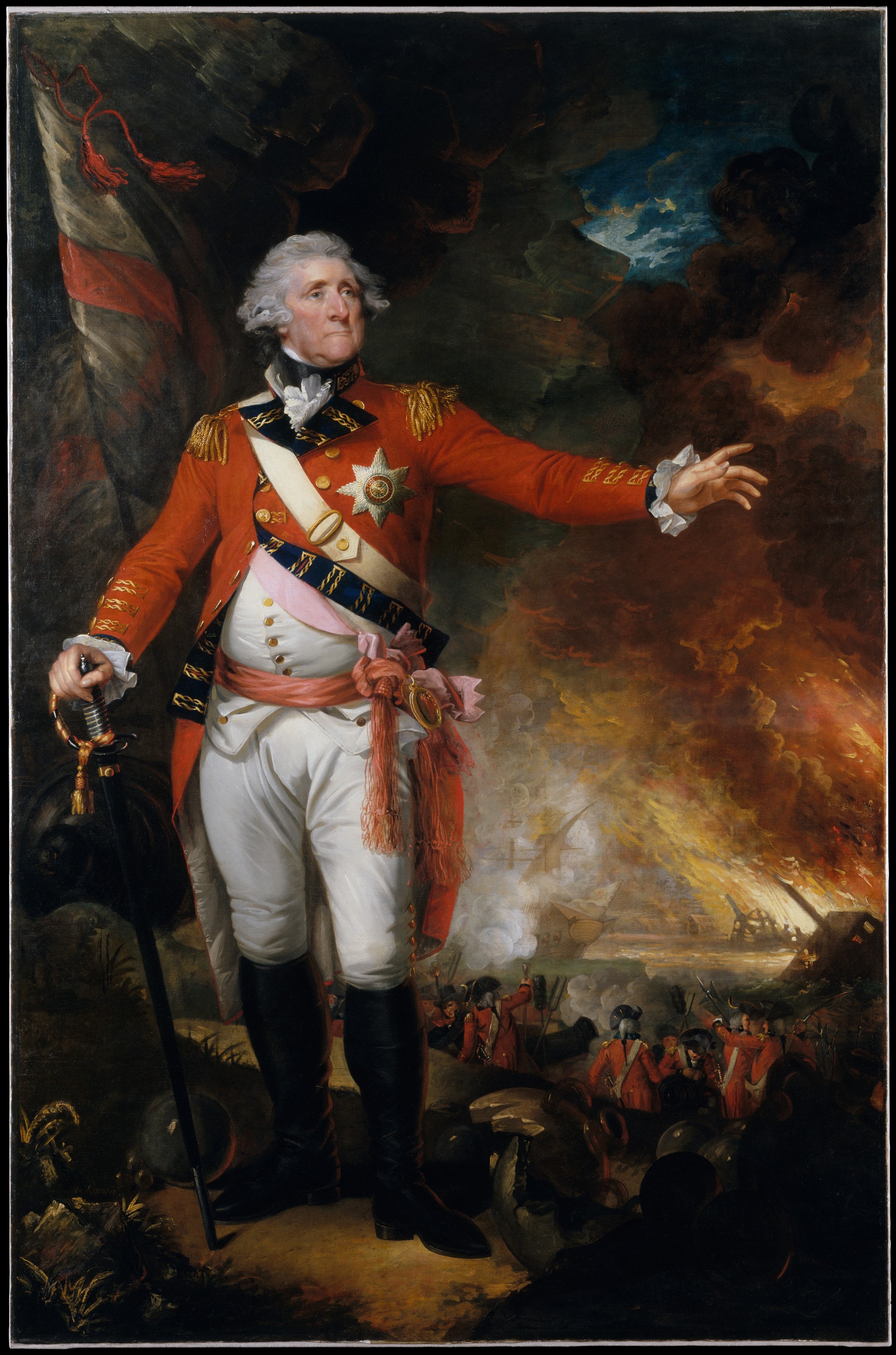|
Koehler Depressing Carriage
The Koehler Depressing Carriage was a novel type of gun carriage invented in 1782 by Lt George Frederick Koehler of the Royal Artillery. It was devised to enable cannon to be fired at a steeply downward-facing angle and was made necessary by the peculiar circumstances that the British Army faced during the Great Siege of Gibraltar between 1779–83. The carriage saw active service during the siege, when it was used to support the British counter-bombardment of Spanish and French artillery batteries during the successful defence of Gibraltar. Its success made Koehler famous and has been commemorated in a number of different forms over the last 230 years. Background During the Great Siege, the British garrison of Gibraltar faced a French and Spanish army entrenched on the low ground of the isthmus that links Gibraltar with Spain. The British controlled the high ground of the Rock of Gibraltar, which reaches a height of at its north end. Although this was a major advantage for th ... [...More Info...] [...Related Items...] OR: [Wikipedia] [Google] [Baidu] |
Recoil
Recoil (often called knockback, kickback or simply kick) is the rearward thrust generated when a gun is being discharged. In technical terms, the recoil is a result of conservation of momentum, as according to Newton's third law the force required to accelerate something will evoke an equal but opposite reactional force, which means the forward momentum gained by the projectile and exhaust gases (ejectae) will be mathematically balanced out by an equal and opposite momentum exerted back upon the gun. In hand-held small arms, the recoil momentum will be eventually transferred to the ground, but will do so through the body of the shooter hence resulting in a noticeable impulse commonly referred to as a "kick". In heavier mounted guns, such as heavy machine guns or artillery pieces, recoil momentum is transferred to the Earth's surface through the platform on which the weapon is mounted. In order to bring the rearward moving gun to a halt, the momentum acquired by the gun is di ... [...More Info...] [...Related Items...] OR: [Wikipedia] [Google] [Baidu] |
Young
Young may refer to: * Offspring, the product of reproduction of a new organism produced by one or more parents * Youth, the time of life when one is young, often meaning the time between childhood and adulthood Music * The Young, an American rock band * ''Young'', an EP by Charlotte Lawrence, 2018 Songs * "Young" (Baekhyun and Loco song), 2018 * "Young" (The Chainsmokers song), 2017 * "Young" (Hollywood Undead song), 2009 * "Young" (Kenny Chesney song), 2002 * "Young" (Place on Earth song), 2018 * "Young" (Tulisa song), 2012 * "Young", by Ella Henderson, 2019 * "Young", by Lil Wayne from '' Dedication 6'', 2017 * "Young", by Nickel Creek from ''This Side'', 2002 * "Young", by Sam Smith from ''Love Goes'', 2020 * "Young", by Silkworm from ''Italian Platinum'', 2002 * "Young", by Vallis Alps, 2015 * "Young", by Pixey, 2016 People Surname * Young (surname) Given name * Young (Korean name), Korean unisex given name and name element * Young Boozer (born 1948), American banker ... [...More Info...] [...Related Items...] OR: [Wikipedia] [Google] [Baidu] |
Lines Of Contravallation Of Gibraltar
The Lines of Contravallation of Gibraltar (Spanish: ''Línea de Contravalación de Gibraltar'' or ''Línea de Gibraltar''), known in English as the "Spanish Lines", were a set of fortifications built by the Spanish across the northern part of the isthmus linking Spain with Gibraltar. They later gave their name to the Spanish town of La Línea de la Concepción. Hughes & Migos, p. 37. The Lines were constructed after 1730 to establish a defensive barrier across the peninsula, with the aim of preventing any British incursions, and to serve as a base for fresh Spanish attempts to retake Gibraltar. They played an important role in the Great Siege of Gibraltar between 1779 and 1783 when they supported the unsuccessful French and Spanish assault on the British-held fortress. The siege was ended after the lines of contravallation were attacked by British and Dutch forces under the command of the Governor of Gibraltar, General Augustus Eliot. The attack caused the Spanish forces to retreat ... [...More Info...] [...Related Items...] OR: [Wikipedia] [Google] [Baidu] |
George Augustus Eliott, 1st Baron Heathfield
George Augustus Eliott, 1st Baron Heathfield, (25 December 1717 – 6 July 1790) was a British Army officer who served in three major wars during the eighteenth century. He rose to distinction during the Seven Years' War when he fought in Germany and participated in the British attacks on Belle Île (France) and Cuba. Eliott is most notable for his command of the Gibraltar garrison during the Great Siege of Gibraltar, which lasted from 1779 and 1783, during the American War of Independence. He was celebrated for his successful defence of the fortress and decisive defeat of Spanish and French attackers. Life Early life Eliott was born at Wells House, near Stobs Castle, Roxburghshire, the 10th (and 8th surviving) son of Sir Gilbert Eliott, 3rd Baronet, of Stobs, by his distant cousin Eleanor Elliot of Brugh and Wells in Roxburghshire. Eleanor's brother was the soldier and courtier William Elliot of Wells. One of his Eleanor's sisters, Charlotte, had married Roger Elliott, anoth ... [...More Info...] [...Related Items...] OR: [Wikipedia] [Google] [Baidu] |
Governor Of Gibraltar
The governor of Gibraltar is the representative of the British monarch in the British overseas territory of Gibraltar. The governor is appointed by the monarch on the advice of the British government. The role of the governor is to act as the ''de facto'' head of state. They are responsible for formally appointing the chief minister of Gibraltar, along with other members of the government of Gibraltar after a general election. The governor serves as commander-in-chief of Gibraltar's military forces and has sole responsibility for defence and security. Although recent appointments have all been former military personnel, most being former Royal Navy or Royal Marines flag officers, Sir James Dutton resigned from the role in 2015, complaining that it was "more representational and ceremonial than I had expected". The governor has his own flag in Gibraltar, the Union Flag defaced with the territory's coat of arms. However, at the governor's official residence ('' The Convent'') ... [...More Info...] [...Related Items...] OR: [Wikipedia] [Google] [Baidu] |
Dennis
Dennis or Denis is a first or last name from the Greco-Roman name Dionysius, via one of the Christian saints named Dionysius. The name came from Dionysus, the Greek god of ecstatic states, particularly those produced by wine, which is sometimes said to be derived from the Greek Dios (Διός, "of Zeus") and Nysos or Nysa (Νῦσα), where the young god was raised. Dionysus (or Dionysos; also known as Bacchus in Roman mythology and associated with the Italic Liber), the Thracian god of wine, represents not only the intoxicating power of wine, but also its social and beneficent influences. He is viewed as the promoter of civilization, a lawgiver, and lover of peace—as well as the patron deity of both agriculture and the theater. Dionysus is a god of mystery religious rites, such as those practiced in honor of Demeter and Persephone at Eleusis near Athens. In the Thracian mysteries, he wears the "bassaris" or fox-skin, symbolizing new life. (See also Maenads.) A mediaeval ... [...More Info...] [...Related Items...] OR: [Wikipedia] [Google] [Baidu] |
John Drinkwater Bethune
Colonel John Drinkwater Bethune (1762–1844), born John Drinkwater, was an English army officer, administrator and military historian, known for his account of the Great Siege of Gibraltar that came out in 1785. Origins Born at Latchford on 9 June 1762, he was the eldest son of John Drinkwater (1740–1797), a surgeon in the Royal Navy, and his first wife Elizabeth Andrews. Career At the age of fifteen he joined the 72nd Regiment of Foot (Royal Manchester Volunteers) as an ensign and was almost immediately posted to Gibraltar. From June 1779 to February 1783 this small British possession was under siege from French and Spanish forces, during which time he kept a careful record of events. When peace came, he had become a captain but his regiment was sent back to Britain and disbanded. From his notes he wrote ''A history of the late siege of Gibraltar, 1779–1783, with a description and account of that garrison from the earliest period'', published in 1785, which was widely re ... [...More Info...] [...Related Items...] OR: [Wikipedia] [Google] [Baidu] |
Principles
A principle is a proposition or value that is a guide for behavior or evaluation. In law, it is a rule that has to be or usually is to be followed. It can be desirably followed, or it can be an inevitable consequence of something, such as the laws observed in nature or the way that a system is constructed. The principles of such a system are understood by its users as the essential characteristics of the system, or reflecting system's designed purpose, and the effective operation or use of which would be impossible if any one of the principles was to be ignored. A system may be explicitly based on and implemented from a document of principles as was done in IBM's 360/370 ''Principles of Operation''. Examples of principles are, entropy in a number of fields, least action in physics, those in descriptive comprehensive and fundamental law: doctrines or assumptions forming normative rules of conduct, separation of church and state in statecraft, the central dogma of molecular biolo ... [...More Info...] [...Related Items...] OR: [Wikipedia] [Google] [Baidu] |
Wadding
Wadding is a disc of material used in guns to seal gas behind a projectile (a bullet or ball), or to separate the propellant from loosely packed shots. Wadding can be crucial to a gun's efficiency, since any gas that leaks past a projectile as it is being fired is wasted. A harder or more carefully designed item which serves this purpose is often called a sabot. Wadding for muzzleloaders is typically a small piece of cloth, or paper wrapping from the cartridge. Shotguns In shotgun shells, the wadding is actually a semi-flexible cup-shaped sabot designed to hold numerous much smaller-diameter sub-projectiles (i.e. shots), and is launched out together as one payload-carrying projectile. This minimizes chaotic collisions of the shots with the bore wall and with each other, allowing the internal ballistics to be more consistent. After leaving the muzzle, the wadding loosens and opens up in flight, allowing the much denser shots to be inertially released and scattered. The same f ... [...More Info...] [...Related Items...] OR: [Wikipedia] [Google] [Baidu] |

.jpg)





